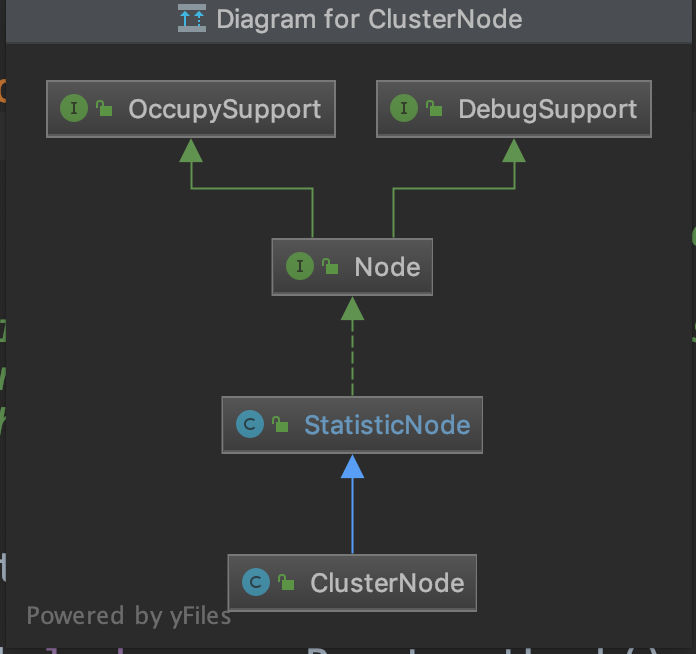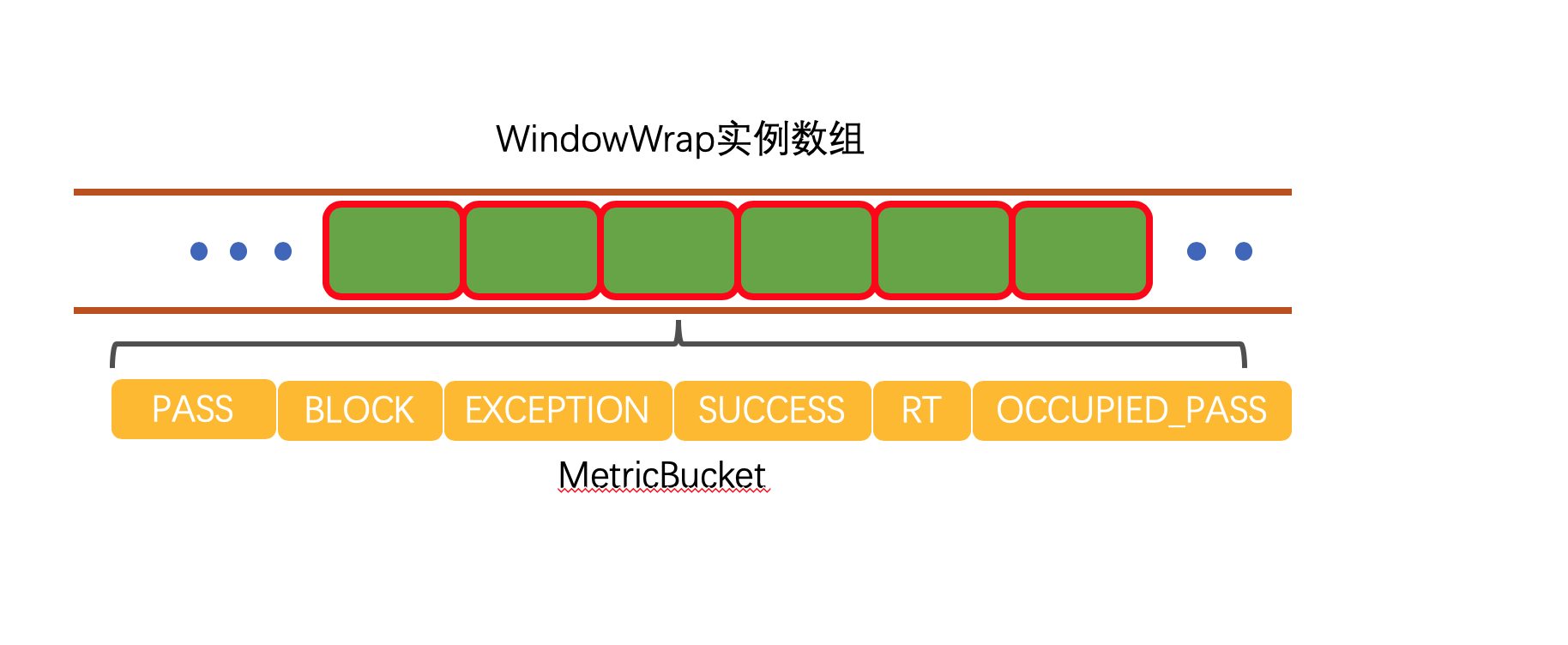最近我很好奇在RPC中限流熔断降级要怎么做,hystrix已经1年多没有更新了,感觉要被遗弃的感觉,那么我就把眼光聚焦到了阿里的Sentinel,顺便学习一下阿里的源代码。
这一章我主要讲的是FlowRuleManager在加载FlowRule的时候做了什么,下一篇正式讲Sentinel如何控制并发数的。
下面我给出一个简化版的demo,这个demo只能单线程访问,先把过程讲清楚再讲多线程版本。
初始化流量控制的规则:限定20个线程并发访问
public class FlowThreadDemo {
private static AtomicInteger pass = new AtomicInteger();
private static AtomicInteger block = new AtomicInteger();
private static AtomicInteger total = new AtomicInteger();
private static AtomicInteger activeThread = new AtomicInteger();
private static volatile boolean stop = false;
private static final int threadCount = 100;
private static int seconds = 60 + 40;
private static volatile int methodBRunningTime = 2000;
public static void main(String[] args) throws Exception {
System.out.println(
"MethodA will call methodB. After running for a while, methodB becomes fast, "
+ "which make methodA also become fast ");
tick();
initFlowRule();
Entry methodA = null;
try {
TimeUnit.MILLISECONDS.sleep(5);
methodA = SphU.entry("methodA");
activeThread.incrementAndGet();
//Entry methodB = SphU.entry("methodB");
TimeUnit.MILLISECONDS.sleep(methodBRunningTime);
//methodB.exit();
pass.addAndGet(1);
} catch (BlockException e1) {
block.incrementAndGet();
} catch (Exception e2) {
// biz exception
} finally {
total.incrementAndGet();
if (methodA != null) {
methodA.exit();
activeThread.decrementAndGet();
}
}
}
private static void initFlowRule() {
List<FlowRule> rules = new ArrayList<FlowRule>();
FlowRule rule1 = new FlowRule();
rule1.setResource("methodA");
// set limit concurrent thread for 'methodA' to 20
rule1.setCount(20);
rule1.setGrade(RuleConstant.FLOW_GRADE_THREAD);
rule1.setLimitApp("default");
rules.add(rule1);
FlowRuleManager.loadRules(rules);
}
private static void tick() {
Thread timer = new Thread(new TimerTask());
timer.setName("sentinel-timer-task");
timer.start();
}
static class TimerTask implements Runnable {
@Override
public void run() {
long start = System.currentTimeMillis();
System.out.println("begin to statistic!!!");
long oldTotal = 0;
long oldPass = 0;
long oldBlock = 0;
while (!stop) {
try {
TimeUnit.SECONDS.sleep(1);
} catch (InterruptedException e) {
}
long globalTotal = total.get();
long oneSecondTotal = globalTotal - oldTotal;
oldTotal = globalTotal;
long globalPass = pass.get();
long oneSecondPass = globalPass - oldPass;
oldPass = globalPass;
long globalBlock = block.get();
long oneSecondBlock = globalBlock - oldBlock;
oldBlock = globalBlock;
System.out.println(seconds + " total qps is: " + oneSecondTotal);
System.out.println(TimeUtil.currentTimeMillis() + ", total:" + oneSecondTotal
+ ", pass:" + oneSecondPass
+ ", block:" + oneSecondBlock
+ " activeThread:" + activeThread.get());
if (seconds-- <= 0) {
stop = true;
}
if (seconds == 40) {
System.out.println("method B is running much faster; more requests are allowed to pass");
methodBRunningTime = 20;
}
}
long cost = System.currentTimeMillis() - start;
System.out.println("time cost: " + cost + " ms");
System.out.println("total:" + total.get() + ", pass:" + pass.get()
+ ", block:" + block.get());
System.exit(0);
}
}
}
FlowRuleManager
在这个demo中,首先会调用FlowRuleManager#loadRules进行规则注册
我们先聊一下规则配置的代码:
private static void initFlowRule() {
List<FlowRule> rules = new ArrayList<FlowRule>();
FlowRule rule1 = new FlowRule();
rule1.setResource("methodA");
// set limit concurrent thread for 'methodA' to 20
rule1.setCount(20);
rule1.setGrade(RuleConstant.FLOW_GRADE_THREAD);
rule1.setLimitApp("default");
rules.add(rule1);
FlowRuleManager.loadRules(rules);
}
这段代码里面先定义一个流量控制规则,然后调用loadRules进行注册。
FlowRuleManager初始化
FlowRuleManager
FlowRuleManager 类里面有几个静态参数:
//规则集合
private static final Map<String, List<FlowRule>> flowRules = new ConcurrentHashMap<String, List<FlowRule>>();
//监听器
private static final FlowPropertyListener LISTENER = new FlowPropertyListener();
//用来监听配置是否发生变化
private static SentinelProperty<List<FlowRule>> currentProperty = new DynamicSentinelProperty<List<FlowRule>>();
//创建一个延迟的线程池
@SuppressWarnings("PMD.ThreadPoolCreationRule")
private static final ScheduledExecutorService SCHEDULER = Executors.newScheduledThreadPool(1,
new NamedThreadFactory("sentinel-metrics-record-task", true));
static {
//设置监听
currentProperty.addListener(LISTENER);
//每一秒钟调用一次MetricTimerListener的run方法
SCHEDULER.scheduleAtFixedRate(new MetricTimerListener(), 0, 1, TimeUnit.SECONDS);
}
在初始化的时候会为静态变量都赋上值。
在新建MetricTimerListener实例的时候做了很多事情,容我慢慢分析。
MetricTimerListener
public class MetricTimerListener implements Runnable {
private static final MetricWriter metricWriter = new MetricWriter(SentinelConfig.singleMetricFileSize(),
SentinelConfig.totalMetricFileCount());
....
}
首次初始化MetricTimerListener的时候会创建一个MetricWriter实例。我们先看传入的两个参数SentinelConfig.singleMetricFileSize()和SentinelConfig.totalMetricFileCount()。
SentinelConfig在首次初始化的时候会初始化静态代码块:
SentinelConfig
static {
try {
initialize();
loadProps();
resolveAppType();
RecordLog.info("[SentinelConfig] Application type resolved: " + appType);
} catch (Throwable ex) {
RecordLog.warn("[SentinelConfig] Failed to initialize", ex);
ex.printStackTrace();
}
}
这段静态代码块主要是设置一下配置参数。
SentinelConfig#singleMetricFileSize
SentinelConfig#totalMetricFileCount
public static long singleMetricFileSize() {
try {
//获取的是 1024 * 1024 * 50
return Long.parseLong(props.get(SINGLE_METRIC_FILE_SIZE));
} catch (Throwable throwable) {
RecordLog.warn("[SentinelConfig] Parse singleMetricFileSize fail, use default value: "
+ DEFAULT_SINGLE_METRIC_FILE_SIZE, throwable);
return DEFAULT_SINGLE_METRIC_FILE_SIZE;
}
}
public static int totalMetricFileCount() {
try {
//默认是:6
return Integer.parseInt(props.get(TOTAL_METRIC_FILE_COUNT));
} catch (Throwable throwable) {
RecordLog.warn("[SentinelConfig] Parse totalMetricFileCount fail, use default value: "
+ DEFAULT_TOTAL_METRIC_FILE_COUNT, throwable);
return DEFAULT_TOTAL_METRIC_FILE_COUNT;
}
}
singleMetricFileSize方法和totalMetricFileCount主要是获取SentinelConfig在静态变量里设入得参数。
然后我们进入到MetricWriter的构造方法中:
MetricWriter
public MetricWriter(long singleFileSize, int totalFileCount) {
if (singleFileSize <= 0 || totalFileCount <= 0) {
throw new IllegalArgumentException();
}
RecordLog.info(
"[MetricWriter] Creating new MetricWriter, singleFileSize=" + singleFileSize + ", totalFileCount="
+ totalFileCount);
// /Users/luozhiyun/logs/csp/
this.baseDir = METRIC_BASE_DIR;
File dir = new File(baseDir);
if (!dir.exists()) {
dir.mkdirs();
}
long time = System.currentTimeMillis();
//转换成秒
this.lastSecond = time / 1000;
//singleFileSize = 1024 * 1024 * 50
this.singleFileSize = singleFileSize;
//totalFileCount = 6
this.totalFileCount = totalFileCount;
try {
this.timeSecondBase = df.parse("1970-01-01 00:00:00").getTime() / 1000;
} catch (Exception e) {
RecordLog.warn("[MetricWriter] Create new MetricWriter error", e);
}
}
构造器里面主要是创建文件夹,设置单个文件大小,总文件个数,设置时间。
讲完了MetricTimerListener的静态属性,现在我们来讲MetricTimerListener的run方法。
MetricTimerListener#run
public void run() {
//这个run方法里面主要是做定时的数据采集,然后写到log文件里去
Map<Long, List<MetricNode>> maps = new TreeMap<Long, List<MetricNode>>();
//遍历集群节点
for (Entry<ResourceWrapper, ClusterNode> e : ClusterBuilderSlot.getClusterNodeMap().entrySet()) {
String name = e.getKey().getName();
ClusterNode node = e.getValue();
Map<Long, MetricNode> metrics = node.metrics();
aggregate(maps, metrics, name);
}
//汇总统计的数据
aggregate(maps, Constants.ENTRY_NODE.metrics(), Constants.TOTAL_IN_RESOURCE_NAME);
if (!maps.isEmpty()) {
for (Entry<Long, List<MetricNode>> entry : maps.entrySet()) {
try {
//写入日志中
metricWriter.write(entry.getKey(), entry.getValue());
} catch (Exception e) {
RecordLog.warn("[MetricTimerListener] Write metric error", e);
}
}
}
}
上面的run方法其实就是每秒把统计的数据写到日志里去。其中Constants.ENTRY_NODE.metrics()负责统计数据,我们下面分析以下这个方法。
Constants.ENTRY_NODE这句代码会实例化一个ClusterNode实例。
ClusterNode是继承StatisticNode,统计数据时在StatisticNode中实现的。

Metrics方法也是调用的StatisticNode方法。
我们先看看StatisticNode的全局变量
public class StatisticNode implements Node {
//构建一个统计60s的数据,设置60个滑动窗口,每个窗口1s
//这里创建的是BucketLeapArray实例来进行统计
private transient volatile Metric rollingCounterInSecond = new ArrayMetric(SampleCountProperty.SAMPLE_COUNT,
IntervalProperty.INTERVAL);
//上次统计的时间戳
private long lastFetchTime = -1;
.....
}
然后我们看看StatisticNode的metrics方法:
StatisticNode#metrics
public Map<Long, MetricNode> metrics() {
// The fetch operation is thread-safe under a single-thread scheduler pool.
long currentTime = TimeUtil.currentTimeMillis();
//获取当前时间的滑动窗口的开始时间
currentTime = currentTime - currentTime % 1000;
Map<Long, MetricNode> metrics = new ConcurrentHashMap<>();
//获取滑动窗口里统计的数据
List<MetricNode> nodesOfEverySecond = rollingCounterInMinute.details();
long newLastFetchTime = lastFetchTime;
// Iterate metrics of all resources, filter valid metrics (not-empty and up-to-date).
for (MetricNode node : nodesOfEverySecond) {
//筛选符合的滑动窗口的节点
if (isNodeInTime(node, currentTime) && isValidMetricNode(node)) {
metrics.put(node.getTimestamp(), node);
//选出符合节点里最大的时间戳数据赋值
newLastFetchTime = Math.max(newLastFetchTime, node.getTimestamp());
}
}
//设置成滑动窗口里统计的最大时间
lastFetchTime = newLastFetchTime;
return metrics;
}
这个方法主要是调用rollingCounterInMinute进行数据的统计,然后筛选出有效的统计结果返回。
我们进入到rollingCounterInMinute是ArrayMetric的实例,所以我们进入到ArrayMetric的details方法中
ArrayMetric#details
public List<MetricNode> details() {
List<MetricNode> details = new ArrayList<MetricNode>();
//调用BucketLeapArray
data.currentWindow();
//列出统计结果
List<WindowWrap<MetricBucket>> list = data.list();
for (WindowWrap<MetricBucket> window : list) {
if (window == null) {
continue;
}
//对统计结果进行封装
MetricNode node = new MetricNode();
//代表一秒内被流量控制的请求数量
node.setBlockQps(window.value().block());
//则是一秒内业务本身异常的总和
node.setExceptionQps(window.value().exception());
// 代表一秒内到来到的请求
node.setPassQps(window.value().pass());
//代表一秒内成功处理完的请求;
long successQps = window.value().success();
node.setSuccessQps(successQps);
//代表一秒内该资源的平均响应时间
if (successQps != 0) {
node.setRt(window.value().rt() / successQps);
} else {
node.setRt(window.value().rt());
}
//设置统计窗口的开始时间
node.setTimestamp(window.windowStart());
node.setOccupiedPassQps(window.value().occupiedPass());
details.add(node);
}
return details;
}
这个方法首先会调用dat.currentWindow()设置当前时间窗口到窗口列表里去。然后调用data.list()列出所有的窗口数据,然后遍历不为空的窗口数据封装成MetricNode返回。
data是BucketLeapArray的实例,BucketLeapArray继承了LeapArray,主要的统计都是在LeapArray中进行的,所以我们直接看看LeapArray的currentWindow方法。
LeapArray#currentWindow
public WindowWrap<T> currentWindow(long timeMillis) {
if (timeMillis < 0) {
return null;
}
//通过当前时间判断属于哪个窗口
int idx = calculateTimeIdx(timeMillis);
//计算出窗口开始时间
// Calculate current bucket start time.
long windowStart = calculateWindowStart(timeMillis);
while (true) {
//获取数组里的老数据
WindowWrap<T> old = array.get(idx);
if (old == null) {
WindowWrap<T> window = new WindowWrap<T>(windowLengthInMs, windowStart, newEmptyBucket(timeMillis));
if (array.compareAndSet(idx, null, window)) {
// Successfully updated, return the created bucket.
return window;
} else {
// Contention failed, the thread will yield its time slice to wait for bucket available.
Thread.yield();
}
// 如果对应时间窗口的开始时间与计算得到的开始时间一样
// 那么代表当前即是我们要找的窗口对象,直接返回
} else if (windowStart == old.windowStart()) {
return old;
} else if (windowStart > old.windowStart()) {
//如果当前的开始时间小于原开始时间,那么就更新到新的开始时间
if (updateLock.tryLock()) {
try {
// Successfully get the update lock, now we reset the bucket.
return resetWindowTo(old, windowStart);
} finally {
updateLock.unlock();
}
} else {
// Contention failed, the thread will yield its time slice to wait for bucket available.
Thread.yield();
}
} else if (windowStart < old.windowStart()) {
//一般来说不会走到这里
// Should not go through here, as the provided time is already behind.
return new WindowWrap<T>(windowLengthInMs, windowStart, newEmptyBucket(timeMillis));
}
}
}
这个方法里首先会传入一个timeMillis是当前的时间戳。然后调用calculateTimeIdx
private int calculateTimeIdx(/*@Valid*/ long timeMillis) {
//计算当前时间能够落在array的那个节点上
long timeId = timeMillis / windowLengthInMs;
// Calculate current index so we can map the timestamp to the leap array.
return (int)(timeId % array.length());
}
calculateTimeIdx方法用当前的时间戳除以每个窗口的大小,再和array数据取模。array数据是一个容量为60的数组,代表被统计的60秒分割的60个小窗口。
举例:
例如当前timeMillis = 1567175708975
timeId = 1567175708975/1000 = 1567175708
timeId % array.length() = 1567175708%60 = 8
也就是说当前的时间窗口是第八个。
然后调用calculateWindowStart计算当前时间开始时间
protected long calculateWindowStart(/*@Valid*/ long timeMillis) {
//用当前时间减去窗口大小,计算出窗口开始时间
return timeMillis - timeMillis % windowLengthInMs;
}
接下来就是一个while循环:
在看while循环之前我们看一下array数组里面是什么样的对象
WindowWrap<T> window = new WindowWrap<T>(windowLengthInMs, windowStart, newEmptyBucket(timeMillis));
WindowWrap是一个时间窗口的包装对象,里面包含时间窗口的长度,这里是1000;窗口开始时间;窗口内的数据实体,是调用newEmptyBucket方法返回一个MetricBucket。
MetricBucket
public class MetricBucket {
private final LongAdder[] counters;
//默认4900
private volatile long minRt;
public MetricBucket() {
MetricEvent[] events = MetricEvent.values();
this.counters = new LongAdder[events.length];
for (MetricEvent event : events) {
counters[event.ordinal()] = new LongAdder();
}
//初始化minRt,默认是4900
initMinRt();
}
...
}
MetricEvent是一个枚举类:
public enum MetricEvent {
PASS,
BLOCK,
EXCEPTION,
SUCCESS,
RT,
OCCUPIED_PASS
}
也就是是MetricBucket为每个窗口通过一个内部数组counters统计了这个窗口内的所有数据。
接下来我们来讲一下while循环里所做的事情:
- 从array里获取bucket节点
- 如果节点已经存在,那么用CAS更新一个新的节点
- 如果节点是新的,那么直接返回
- 如果节点失效了,设置当前节点,清除所有失效节点
举例:
1. 如果array数据里面的bucket数据如下所示:
B0 B1 B2 NULL B4
||_______|_______|_______|_______|_______||___
200 400 600 800 1000 1200 timestamp
^
time=888
正好当前时间所对应的槽位里面的数据是空的,那么就用CAS更新
2. 如果array里面已经有数据了,并且槽位里面的窗口开始时间和当前的开始时间相等,那么直接返回
B0 B1 B2 B3 B4
||_______|_______|_______|_______|_______||___
200 400 600 800 1000 1200 timestamp
^
time=888
3. 例如当前时间是1676,所对应窗口里面的数据的窗口开始时间小于当前的窗口开始时间,那么加上锁,然后设置槽位的窗口开始时间为当前窗口开始时间,并把槽位里面的数据重置
(old)
B0 B1 B2 NULL B4
|_______||_______|_______|_______|_______|_______||___
... 1200 1400 1600 1800 2000 2200 timestamp
^
time=1676
所以上面的array数组大概是这样:

array数组由一个个的WindowWrap实例组成,WindowWrap实例里面由MetricBucket进行数据统计。
然后继续回到ArrayMetric的details方法,讲完了上面的data.currentWindow(),现在再来讲data.list()
list方法最后也会调用到LeapArray的list方法中:
LeapArray#list
public List<WindowWrap<T>> list(long validTime) {
int size = array.length();
List<WindowWrap<T>> result = new ArrayList<WindowWrap<T>>(size);
for (int i = 0; i < size; i++) {
WindowWrap<T> windowWrap = array.get(i);
//如果windowWrap节点为空或者当前时间戳比windowWrap的窗口开始时间大超过60s,那么就跳过
//也就是说只要60s以内的数据
if (windowWrap == null || isWindowDeprecated(validTime, windowWrap)) {
continue;
}
result.add(windowWrap);
}
return result;
}
这个方法是用来把array里面都统计好的节点都找出来,并且是不为空,且是当前时间60秒内的数据。
最后Constants.ENTRY_NODE.metrics() 会返回所有符合条件的统计节点数据然后传入aggregate方法中,遍历为每个MetricNode节点设置Resource为TOTAL_IN_RESOURCE_NAME,封装好调用metricWriter.write进行写日志操作。
最后总结一下在初始化FlowRuleManager的时候做了什么:
- FlowRuleManager在初始化的时候会调用静态代码块进行初始化
- 在静态代码块内调用ScheduledExecutorService线程池,每隔1秒调用一次MetricTimerListener的run方法
- MetricTimerListener会调用
Constants.ENTRY_NODE.metrics()进行定时的统计- 调用StatisticNode进行统计,统计60秒内的数据,并将60秒的数据分割成60个小窗口
- 在设置当前窗口的时候如果里面没有数据直接设置,如果存在数据并且是最新的直接返回,如果是旧数据,那么reset原来的统计数据
- 每个小窗口里面的数据由MetricBucket进行封装
- 最后将统计好的数据通过metricWriter写入到log里去
FlowRuleManager加载规则
FlowRuleManager是调用loadRules进行规则加载的:
FlowRuleManager#loadRules
public static void loadRules(List<FlowRule> rules) {
currentProperty.updateValue(rules);
}
currentProperty这个实例是在FlowRuleManager是在静态代码块里面进行加载的,上面我们讲过,生成的是DynamicSentinelProperty的实例。
我们进入到DynamicSentinelProperty的updateValue中:
public boolean updateValue(T newValue) {
//判断新的元素和旧元素是否相同
if (isEqual(value, newValue)) {
return false;
}
RecordLog.info("[DynamicSentinelProperty] Config will be updated to: " + newValue);
value = newValue;
for (PropertyListener<T> listener : listeners) {
listener.configUpdate(newValue);
}
return true;
}
updateValue方法就是校验一下是不是已经存在相同的规则了,如果不存在那么就直接设置value等于新的规则,然后通知所有的监听器更新一下规则配置。
currentProperty实例里面的监听器会在FlowRuleManager初始化静态代码块的时候设置一个FlowPropertyListener监听器实例,FlowPropertyListener是FlowRuleManager的内部类:
private static final class FlowPropertyListener implements PropertyListener<List<FlowRule>> {
@Override
public void configUpdate(List<FlowRule> value) {
Map<String, List<FlowRule>> rules = FlowRuleUtil.buildFlowRuleMap(value);
if (rules != null) {
flowRules.clear();
//这个map的维度是key是Resource
flowRules.putAll(rules);
}
RecordLog.info("[FlowRuleManager] Flow rules received: " + flowRules);
}
....
}
configUpdate首先会调用FlowRuleUtil.buildFlowRuleMap()方法将所有的规则按resource分类,然后排序返回成map,然后将FlowRuleManager的原来的规则清空,放入新的规则集合到flowRules中去。
FlowRuleUtil#buildFlowRuleMap
这个方法最后会调用到FlowRuleUtil的另一个重载的方法:
public static <K> Map<K, List<FlowRule>> buildFlowRuleMap(List<FlowRule> list, Function<FlowRule, K> groupFunction,
Predicate<FlowRule> filter, boolean shouldSort) {
Map<K, List<FlowRule>> newRuleMap = new ConcurrentHashMap<>();
if (list == null || list.isEmpty()) {
return newRuleMap;
}
Map<K, Set<FlowRule>> tmpMap = new ConcurrentHashMap<>();
for (FlowRule rule : list) {
//校验必要字段:资源名,限流阈值, 限流阈值类型,调用关系限流策略,流量控制效果等
if (!isValidRule(rule)) {
RecordLog.warn("[FlowRuleManager] Ignoring invalid flow rule when loading new flow rules: " + rule);
continue;
}
if (filter != null && !filter.test(rule)) {
continue;
}
//应用名,如果没有则会使用default
if (StringUtil.isBlank(rule.getLimitApp())) {
rule.setLimitApp(RuleConstant.LIMIT_APP_DEFAULT);
}
//设置拒绝策略:直接拒绝、Warm Up、匀速排队,默认是DefaultController
TrafficShapingController rater = generateRater(rule);
rule.setRater(rater);
//获取Resource名字
K key = groupFunction.apply(rule);
if (key == null) {
continue;
}
//根据Resource进行分组
Set<FlowRule> flowRules = tmpMap.get(key);
if (flowRules == null) {
// Use hash set here to remove duplicate rules.
flowRules = new HashSet<>();
tmpMap.put(key, flowRules);
}
flowRules.add(rule);
}
//根据ClusterMode LimitApp排序
Comparator<FlowRule> comparator = new FlowRuleComparator();
for (Entry<K, Set<FlowRule>> entries : tmpMap.entrySet()) {
List<FlowRule> rules = new ArrayList<>(entries.getValue());
if (shouldSort) {
// Sort the rules.
Collections.sort(rules, comparator);
}
newRuleMap.put(entries.getKey(), rules);
}
return newRuleMap;
}
这个方法首先校验传进来的rule集合不为空,然后遍历rule集合。对rule的必要字段进行校验,如果传入了过滤器那么校验过滤器,然后过滤resource为空的rule,最后相同的resource的rule都放到一起排序后返回。
注意这里默认生成的rater是DefaultController。
到这里FlowRuleManager已经分析完毕了,比较长。